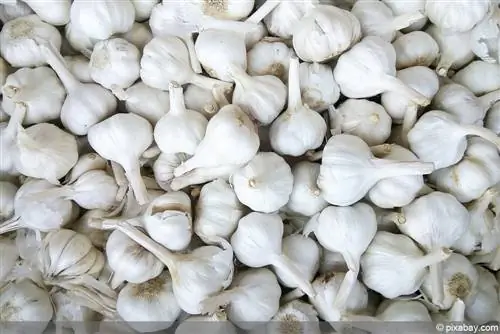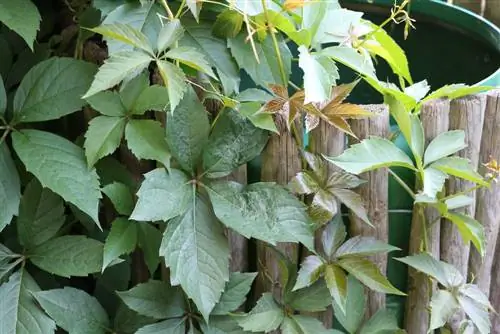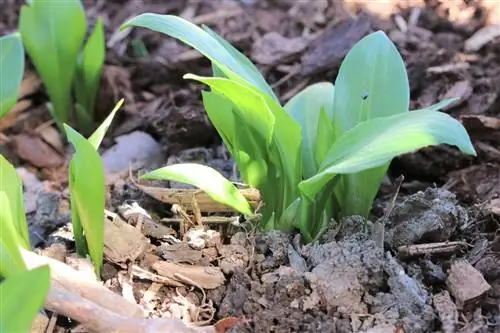- Author admin [email protected].
- Public 2023-12-17 03:39.
- Last modified 2025-06-01 06:48.
The cultivation works with breeding onions or even the usual garlic bulbs. However, onions are only harvested after two years, while garlic cloves are harvested more quickly. There are a few things to keep in mind when caring for them, then nothing will stand in the way of a bountiful harvest.
Short profile - Garlic
- Allium sativum
- Genus Leek
- Spice and medicinal plant
- Originally from the steppe regions of Central and South Asia
- Known since ancient times
- Perennial herbaceous plant
- 30 to 90 cm high
- Flat, bluish green leaves
- Onion plant, 1 main clove and 5 to 20 secondary cloves
- Taste of the toes spicy-aromatic
- Sticky juice
- Stem sprouts from the middle of the main clove
- Dummy inflorescence with white or pink flowers
Planting garlic
Growing garlic in the garden or even in a pot on the balcony is incredibly easy. An appropriate plant substrate and plenty of sun are important. All you need to plant is a fresh clove of garlic or directly sprouting onions. Experts advise not to plant garlic near other bulbous plants. Legumes are also rather unsuitable as neighbors. Growth inhibition often occurs. The tubers that you have chosen for planting should be divided about a week before planting. The individual toes must not be rotten, injured or covered with mold spores. Only use he althy toes!
Tip:
Garlic from the supermarket usually comes from China or other warm countries. He is not used to our Central European climate and doesn't get along very well. So it's better to ask farmers about local plants or garlic bulbs at the vegetable and weekly markets.
Planting time
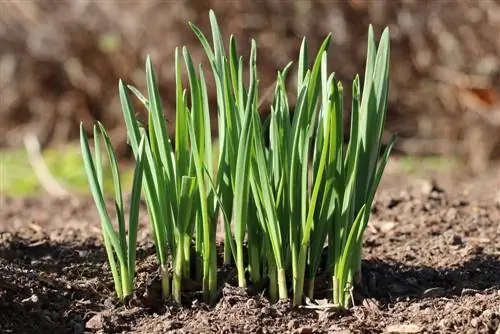
If you want to grow garlic, it's best to start in spring or autumn. The months of September and October are ideal for creating beautiful big toes. The planting time is good because the roots develop well in the still warm soil and the garlic is already sprouting in spring. The harvest is usually more plentiful than with spring planting, although the plants grow more slowly. Harvesting takes place in July. This sowing date has the advantage that the onions do not have to be stored over the winter. Many then move out prematurely. In spring, March is the best time to tuck your toes.
- September and October
- Alternatively in March
Plants in the garden
In the garden you should look for a dry, somewhat sheltered place. Garlic cannot tolerate constant moisture in the soil. The plants also need sun. It is ideal to plant garlic in a mixed culture. If you place the toes between other plants, aphids are kept away. Nor does gray mold develop in their society. Interplanting is particularly beneficial for strawberries, cucumbers, carrots, roses, tulips, lilies and tomatoes.
- Dry sheltered place
- Very sunny
- Good in mixed culture - keeps diseases and pests away
Plants in containers
Containers are generally suitable for growing garlic, regardless of whether they are in a balcony box or a larger container. It is ideal to install drainage at the bottom so that excess water can flow away quickly. Waterlogging is absolutely harmful. Gravel is suitable as drainage or simply use smaller stones. Since overwintering in the pot is difficult because the soil must not freeze, it is better not to start growing until spring.
- Good for vessels
- Install drainage
Planting soil
The right plant substrate is very important for the development of garlic plants. It should be loose, permeable and rich in nutrients. A high proportion of humus is important. Compost from your own garden is extremely helpful. Many hobby gardeners swear by sandy and deep loamy soil. These are probably particularly suitable for growing garlic. The harvest is lower on purely sandy soils.
- Loose, permeable, nutrient-rich
- Sandy, deep clay soils
Plants
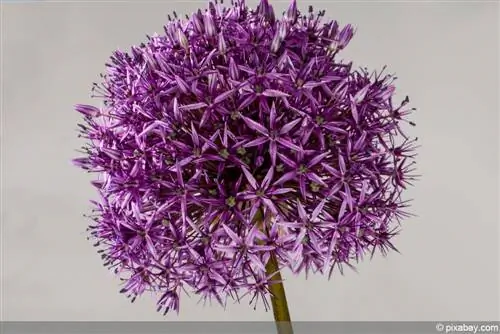
There is not much to consider when planting. The soil should be nicely loosened and free of weeds. The tubers are removed from the outer skins and divided into individual cloves. Care must be taken to avoid injuring the toes. The tubers are planted in the ground like flower bulbs. The best way to do this is with a planting piece of wood. Simply make a hole in the ground and insert the toe into it. If you want to grow several plants, it's best to put the toes in a row, nice and straight and neat. The safest way to do this is to stretch a string along which the holes are then pierced. The distance between the toes should be at least 10 cm and the depth should be about 2.5 to 5 cm. If you plan several rows, you should maintain a row spacing of 45 cm. It is important to place the garlic cloves in the soil at an angle so that the water does not collect at the roots but drains away. The tip must point upwards. Finally, water well. It's a good idea to mulch the soil, and plenty of it.
- Loose soil
- Weedfree
- Planting distance 10 to 15 cm
- 2, 5 to 5 cm deep
- Row spacing 20 to 45 cm
- Lay diagonally in the ground
- Top up
- Watering and mulching
Tip:
Experts recommend only growing garlic in the same place for one year at a time and then taking a break from cultivation for up to five years. This prevents diseases and pests. Also, no other lily plants such as onions should be planted there.
Caring for Garlic
There is not much to do when caring for garlic. It is important that the soil is kept free of weeds, as this competition is unfavorable for the plants. Otherwise, you need to water regularly, but neither too much nor too little. Compost is suitable as fertilizer. If there is a nutrient deficiency, use organic fertilizer. Overwintering in the bed is uncomplicated. It is better to overwinter garlic in containers indoors. Pests are rare. Illnesses are often caused by too much moisture.
Pouring
Too much moisture is unfavorable for garlic, but so is prolonged dryness. A uniform, light humidity is ideal, which should be maintained throughout. If the soil is heavily mulched, moisture can be retained longer and watering does not need to be as much. The layer retains the sun's heat for longer, but at the same time reduces the evaporation of water.
- Don’t water too much
- Don’t let it dry out
- Mulch layer is ideal
- Tap water is sufficient
Fertilize
Fertilizing is not necessary, especially if sufficient humus, e.g. in the form of compost, has been mixed in. Conventional fertilizer is more harmful than beneficial unless you use organic fertilizer for vegetable plants. After all, the garlic should be used and you don't want to eat any chemicals. The yield increases with nitrogen fertilization, but if you really want aromatic garlic, it is better to leave out this special fertilization.
- Fertilize only with compost
- Use organic fertilizer
Wintering
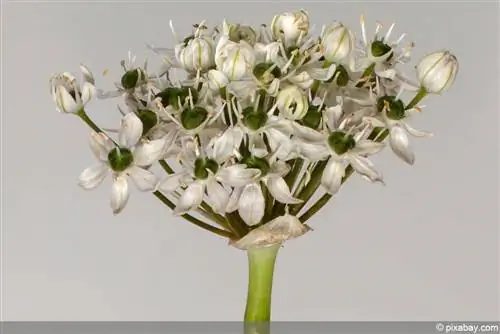
Although garlic is quite robust, winter protection is still cheap. A cover of mulch or brushwood is good for the so-called winter garlic, as it protects it from frost but also from too much moisture. It is important to protect garlic in containers from the soil freezing. Frost damage can be avoided by placing the boxes and tubs close to the warm wall of the house, if possible under a roof eaves (but then don't forget to water every now and then) and putting them up a bit and packing them up.
- Cover winter garlic with mulch or brushwood
- Protect from cold or better yet from wet
- It is better to overwinter the pot in the house, between 5 and 10°C
Diseases and pests
Garlic is extremely rarely attacked by pests. The plants successfully ward off most of them. This not only benefits the garlic plants themselves, but also protects neighbors from lice, flies, bedbugs and spiders. They cannot smell the scent of the leek plants. Leek moths can appear from time to time. Their caterpillars eat large tunnels through the leaves, which can lead to the death of the plants. However, diseases do occur from time to time, mainly fungal diseases. If a fungal disease has occurred on garlic, these plants should not be used for propagation.
- White rot - caused by mold
- Garlic rust - rusty brown coating on the shoots, usually caused by too much moisture. The remedy is less moisture and removing the affected plants
- Fungal infestation - low humidity and loosen the soil
Propagate garlic
Garlic is only propagated vegetatively, but there are two options. You use either the sizzling onions or normal garlic cloves. Both types should be carried out as described above. The harvest from brood onions is postponed by one year. In the first year only a round tuber develops. The typical garlic bulb only emerges in the second year.
Conclusion
Garlic is delicious and he althy. It should not be missing in any garden. It is particularly recommended to place it between other vegetable or fruit plants, as it repels insects and protects against some diseases. There are not many things to pay attention to when growing. A good substrate and a protected, sunny spot are usually enough. A nutrient-rich, humus-rich soil is favorable. With mulched soil you save some watering. The best way to fertilize is with compost. The harvest time can be recognized by the green of the leaves. If they slowly turn yellow and then brown, they can be harvested.

